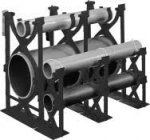If I'm running underground conduits not encased in concrete, do I have to keep them all on a single row or can I stack them in two rows with spacers still without concrete encasement?
Or is that when you need to encase in concrete when you have more than one row?
Thanks
Or is that when you need to encase in concrete when you have more than one row?
Thanks

